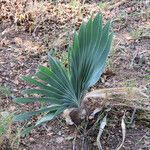Bulb up to 25 cm. in diameter, the upper part with dry loose tunics of old leaf-bases, often emergent from the ground.. Leaves grey-green or glaucous, up to 60 cm. long, 1.5–4 cm. broad, glabrous, developing after the flowers.. Scape 5–30 cm. long, with a globose inflorescence of 50 to more than 100 flowers.. Pedicels angular, 3–8 cm. long at anthesis, elongating up to 40 cm. in fruit.. Flowers pink to dark purple; tube narrowly funnel-shaped, always shorter than the segments, 0.5–2 cm.; segments gradually spreading, recurved towards the apex, with slightly incurved margins, 2–3 cm. long, 2–4 mm. broad.. Filaments 3–4.5 cm. long; anthers yellow, 2.5–3.5 mm.. Style 5 cm.. Capsule triquetrous, up to 3 cm. long, with irregular dehiscence, often sterile.. Fig. 6.
Geophyte, up to 300 mm high. Bulb 120-170 mm high, 100-150 mm in diameter with a thick tunic of dry membranous leaf bases. Leaves distichous, greyish green, erect, arranged in a conspicuous fan. Flowers: in a dense, many-flowered umbel; stamens stiffly exserted; pedicels elongate after flowering to produce a large seed head, up to 150 mm long; perianth ± 30 mm long, shades of pink to red, usually bright pink; Oct.-Jan. Fruit an indehiscent, 3-ribbed capsule.
Perennial geophyte, 0.2-0.5 m high; bulb usually exposed, tunics parchment-like. Leaves 12-20, dry at flowering, in an upright fan, lanceolate, 10-40 mm wide, channelled, grey-green, edges ± undulate. Flowers 50-100 or more, in a dense, brush-like cluster, pink to red, fragrant; perianth tube 5-10 mm long, segments recurved, 20-30 mm long; pedicels lengthening considerably in fruit. Flowering time Sept.-Mar.
Bulbous geophytes, 25-50 cm. Leaves 12-20, usually dry at flowering, in an upright fan, lanceolate, channelled, grey, edges usually undulate, apex acute. Flowers 50-100 or more, in a dense, spreading cluster, pink to red, fragrant, pedicels elongating in fruit.
Bulbous geophyte, 250-500 mm tall. Leaves many, usually dry at flowering time, in an upright fan, margins often undulate, tips acute. Flowers in a dense spreading cluster, pink to red, pedicels elongating in fruit.
Geophyte, up to 300 mm tall. Bulb 120-170 mm in height, 100-150 mm in diameter with a thick tunic of dry membranous leaf bases. Leaves distichous. Inflorescence densely many-flowered. Flowers bright pink.
A bulb plant.

